What sounds do degus make? Did you know degus make other sounds than squeaks?
Click the name of each sound when you see this icon  to hear a sample clip.
to hear a sample clip.

Degus have a complex vocal repertoire for communicating31
and in fact use as many as 15 unique sounds to do so157.
The complete range, structure and functions of vocalisations used by Degus has only
recently been analysed in detail by Degutopia. Following is an overview of each type
of sound discovered to be used by degus in day to day life (further details can
be found in the papers157
, 169).
To listen to an audio walkthrough of some of these sounds (approx. 4 mins), click the button below:
Note:
Conspecific: a member of the same species that is
not the observed animal (i.e. another degu).
Heterospecific: a member of
another species (i.e. an animal that is not a degu).
Agonistic: meaning
projecting aggression toward.
1.  "Whine"
"Whine"
Profile157:
A soft, drawn out sound of
average duration 0.288 s. This vocalisation has a frequency range of 6.5 kHz to
1.8 kHz, consisting typically of an unmodulated fundamental frequency. Most
commonly used singularly to 6 times in succession and followed by a ‘groan’
vocalisation. Expression: No obvious physical characteristics but often
accompanied by mildly agonistic behaviours such as forearm pushing, shouldering
and back turning. Typically directed toward a conspecific. Used by males and
females of all ages, most commonly in agonistic situations. Effect: Causes
conspecific to back away, turn around or in some cases respond by ‘whining’ and
shouldering or pushing. Likely function: Mild threat or warning of further
agonistic action intended to repel conspecific.
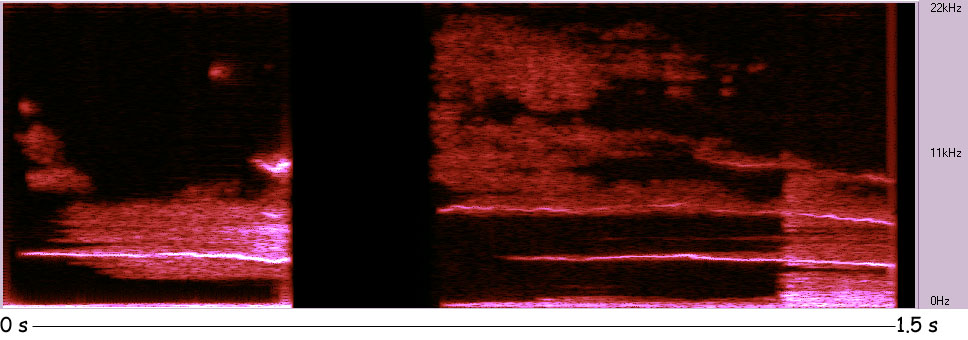
~~
2.  "Groan"
"Groan"
Profile157:
A harsh sound of average
duration 0.31 s. This vocalisation has a frequency range of 9.2 kHz to 761 Hz,
consisting typically of 4 or 5 unmodulated harmonics. Most commonly used
singularly to 5 times in succession and preceded by a ‘whine’ vocalisation, may
be interspersed with ‘chirps’. Expression: Often vocalised with an open mouth,
sometimes accompanied by pinning back of ears, typically directed toward a
conspecific. May be followed by threatening agonistic behaviours such as
lunging, scrabbling with forepaws and boxing. Used by juvenile to adult males
and females, most commonly during agonistic encounters. Effect: Causes
conspecific to move away from subject. Sometimes triggers responding ‘whine’ and
‘groan’ vocalisations, accompanied by lunging and boxing. Likely function:
Strong threat or warning of further agonistic action intended to repel
conspecific.
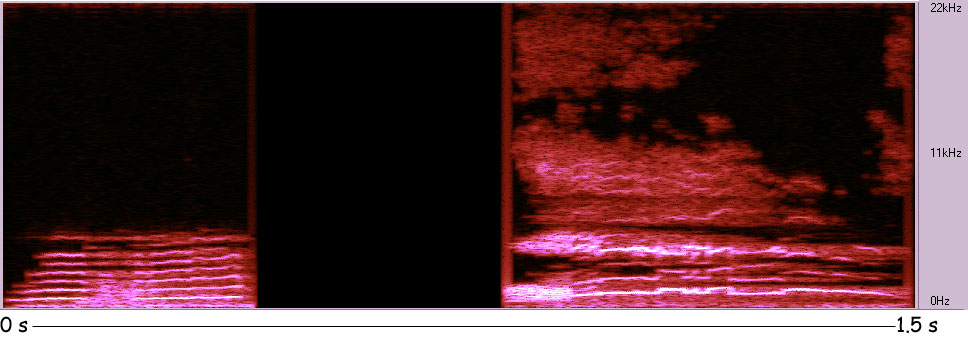
~~
3.  "Chaff"
"Chaff"
Profile157:
A rasping sound of average
duration 0.103 s. This vocalisation has a frequency range of 12.1 kHz to 2 kHz,
consisting typically of broad spectrum frequencies. Most commonly used three
times in succession, singularly or up to 15 times in succession, sometimes
interspersed with ‘chirps’. Expression: Sometimes vocalised with an open mouth,
this vocalisation is often used when the subject is some distance away from a
conspecific, but typically directed toward them. Used by males and females of
all ages, usually in agonistic encounters. Effect: Chaffs are directed toward
conspecifics which are then more likely to approach the subject. Likely
function: Encourages approach (and allows subsequent investigation) of a distant
conspecific.
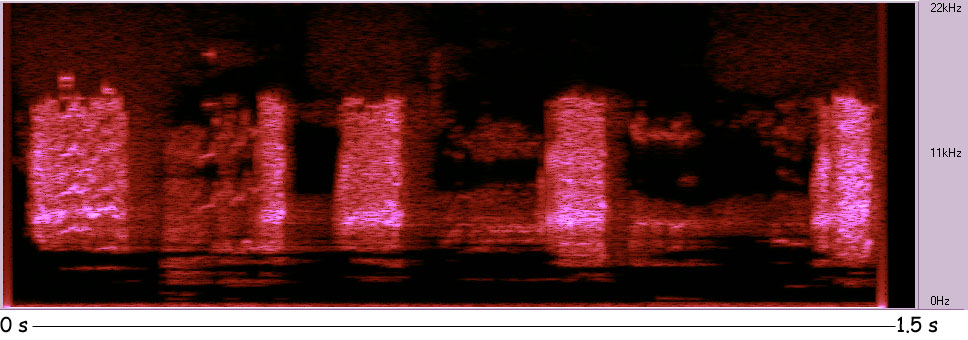
~~
4.  "Warble"
"Warble"
Profile157:
A soft, high-pitched sound of average duration 0.16 s. This vocalisation has a
frequency range of 10.9 kHz to 3.3 kHz, consisting typically of a positively
modulated fundamental frequency. Most commonly used singularly to twice in
succession, usually preceded by another vocalisation such as the ‘chitter’,
‘trill’ or ‘chaff’. Expression: Mouth may open towards end of vocalisation,
sometimes accompanied by ‘tail beating’. May be directed toward a conspecific or
broadcast. Used by males and females of all ages, most commonly during novel
encounters and during pup care. Effect: Can trigger ‘chittering’, tail beating
and sometimes ‘warbling’ in conspecifics within auditory range, and can
stimulate play behaviour. Likely function: May outwardly indicate emotional
states such as pleasure, arousal or excitement, which could trigger reciprocal
behaviours such as play.
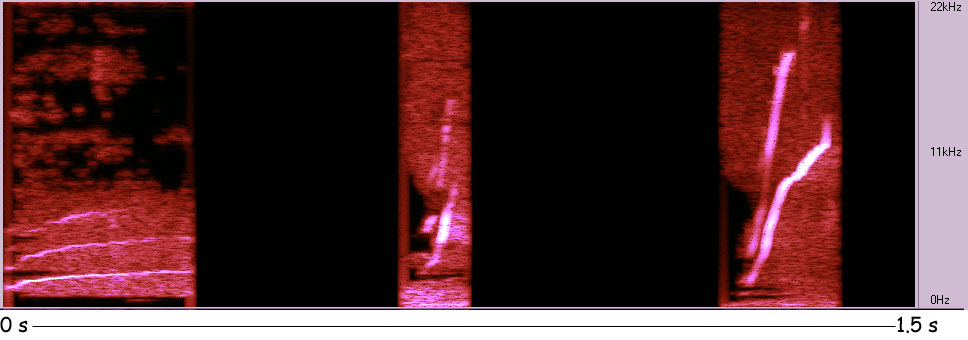
~~
5.  "Chirp"
"Chirp"
Profile157:
A sound of average duration 0.04 s. This vocalisation has a frequency range of
3.2 kHz to 697 Hz, consisting typically of a single harmonic with
positive-negative modulation. Most commonly used three times in succession,
singularly or up to 16 times in succession and usually mixed between other
vocalisations such as the ‘whine’, ‘groan’, ‘chaff’ and ‘tweet’. Expression: No
obvious outward physical characteristics, typically directed toward a
conspecific. Used by males and females of all ages, most commonly during
agonistic encounters. Effect: Has no obvious effect on conspecific but may be
related to a reduced tendency toward agonistic actions. Likely function: May
discourage conspecific against taking further agonistic action against
subject.
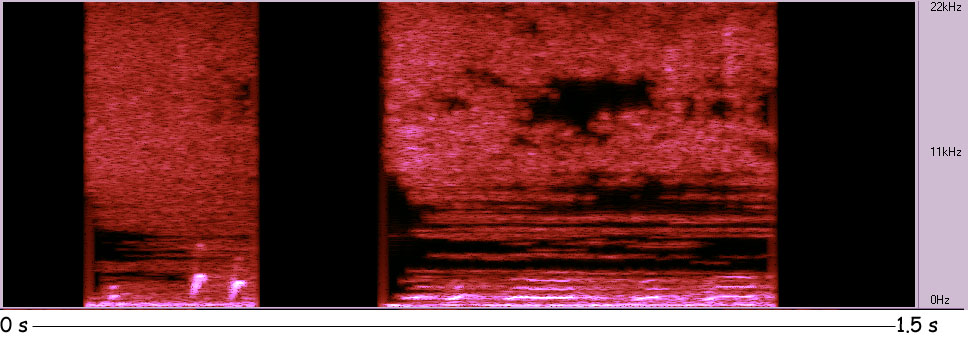
~~
6.  "Chitter"
"Chitter"
Profile157:
A soft, repetitive, high-pitched sound of average duration 0.03 s. This
vocalisation has a frequency range of 3.4 kHz to 1.1 kHz, consisting typically
of a fundamental frequency with positive-negative modulation. Most commonly used
4 times in succession, singularly or up to 11 times in succession. Expression:
No obvious outward physical characteristics but usually accompanied by
conspecific nose-nose contact, nose-mouth contact and/or grooming behaviours.
More frequently heard between closely bonded group members upon encounter,
typically directed toward a conspecific. Used by males and females of all ages,
most commonly during affiliative encounters. Effect: Often stimulates reciprocal
chittering from conspecific and further nose-nose contact or allogrooming.
Likely function: Used as a greeting and encourages social
bonding.
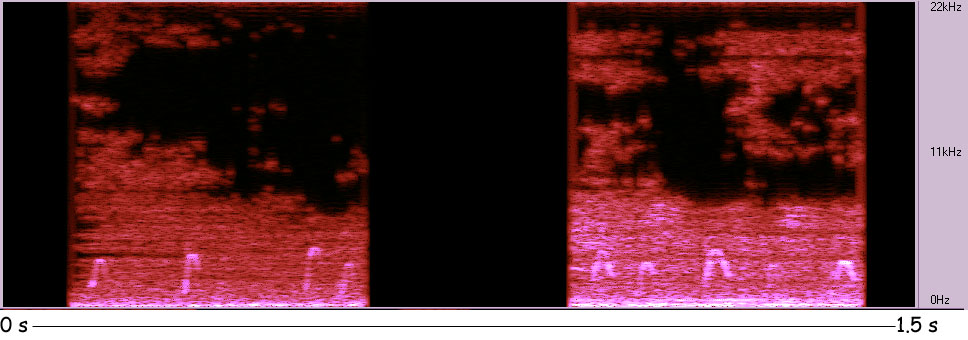
~~
7.  "Wheep"
"Wheep"
Profile157:
A loud sound of average duration 0.1 s. This vocalisation has a frequency range
of 14.9 kHz to 4.2 kHz, consisting typically of broad spectrum frequencies. Most
commonly used two times in succession, singularly or up to 7 times in
succession, it is usually followed by periods of complete silence. Expression:
Usually vocalised with an open mouth and pinning back of the ears, typically
broadcast. Used by juvenile to adult males and females, typically during
environmental concern or alarm. Effect: Followed immediately by periods of
silence and vigilance in the subject, all other degus in hearing range respond
immediately by fleeing/hiding and/or freezing. Likely function: Used as an alarm
call to warn conspecifics in auditory range of potential or immediate
danger.
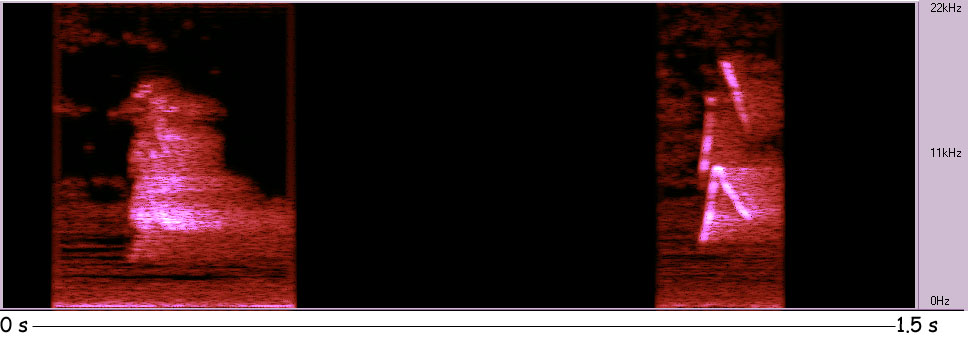
~~
8.  "Squeal"
"Squeal"
Profile157:
A loud sound of average duration 0.245 s. This vocalisation has a frequency
range of 14.8 kHz to 1.1 kHz, consisting typically of broad spectrum frequencies
23.1%. Most commonly used singularly, it is usually preceded by vocalisations
such as the ‘groan’, ‘whine’ and ‘chirp’. Expression: Usually vocalised with an
open mouth and pinning back of the ears, may be directed toward a conspecific or
broadcast. Used by juvenile to adult males and females, most commonly during
agonistic encounters. Effect: Rapid, simultaneous movement of the subject away
from the cause (most typically mouth-body contact (biting) from a conspecific).
Likely function: Probably an involuntary vocalisation as the result of a painful
experience, may also alarm conspecific or predator and allow subject to
escape.
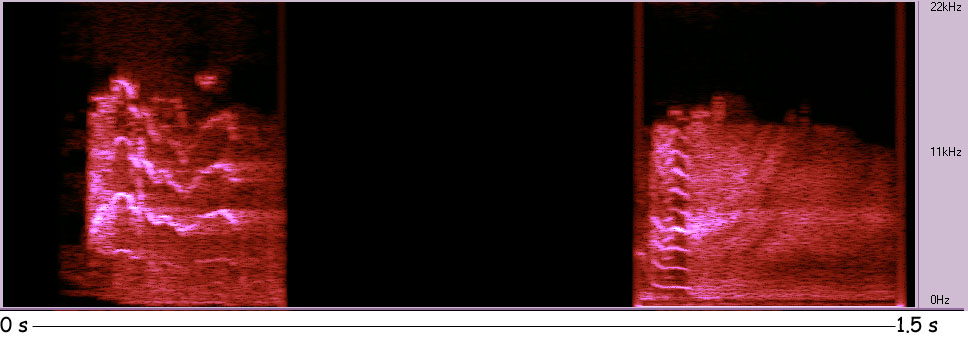
~~
9.  "Pip"
"Pip"
Profile157:
A soft sound of average duration 0.048 s. This vocalisation has a frequency
range of 11.4 kHz to 1.6 kHz Hz, consisting typically of 3 or 5 harmonics with
positive-negative modulation 22.2%. Most commonly used singularly, it is
sometimes preceded by ‘chitter’ vocalisations. Expression: Sometimes vocalised
with an open mouth, usually during grooming by a conspecific, typically directed
toward a conspecific. Used by males and females in pups and adult degus, most
commonly during pup care and also during grooming by conspecific. Effect: Causes
conspecific to momentarily cease grooming. Grooming may continue after
vocalising. Likely function: May serve as an indication of over-enthusiastic
grooming by conspecific, as a result of mild discomfort or
pain.

~~
10.  "Grunt"
"Grunt"
Profile157:
A harsh sound of average duration 0.073 s. This vocalisation has a frequency
range of 9.9 kHz to 416 Hz, consisting of broad spectrum frequencies. Most
commonly used 3 times in succession, singularly or up to 5 times in succession,
it is usually followed by vocalisations such as the ‘whine’ and ‘groan’.
Expression: Usually vocalised with an open mouth, typically directed toward a
conspecific. May be unique to juvenile to adult males, most commonly during
agonistic encounters. Effect: Causes conspecific to move or run away from
subject. Likely function: A strong threat or warning of immediate agonistic
action intended to repel conspecific.

~~
11.  "Bark"
"Bark"
Profile157:
A loud, repetitive sound of average duration 0.125. This vocalisation has a
frequency range of 15.8 kHz to 2.8 kHz, consisting typically of 3 harmonics with
positive-negative modulation 24.1%. Most commonly used 11+ times in succession
(but may be used well over 20+ times in succession), it can be used exclusively
for periods of up to 60 minutes. Expression: Usually vocalised with an open
mouth and pinning back of the ears. More frequently used by juvenile to adult
males after mating, but also used by juvenile to adult females after agonistic
encounters or during environmental concern. Typically broadcast. Effect:
Increased vigilance and silence of conspecifics within auditory range. Likely
function: In the case of males post copulation this is likely to serve as a
territorial warning directed toward other males. Females may also use the call
as a territorial alarm after environmental concern/disturbance.

~~
12.  "Tweet"
"Tweet"
Profile157:
A sound of average duration 0.08 s. This vocalisation has a frequency range of
10.4 kHz to 2.8 kHz, consisting typically of 2 harmonics with positive-negative
modulation. Most commonly used 4 times in succession, singularly to up to 10
times in succession. Expression: Vocalised with an open mouth, usually during
agonistic encounters but also shortly before or during mounting of subject by
conspecific. Typically directed toward a conspecific. Used by juvenile to adult
males and females. Effect: No obvious effects, sometimes linked with
dismounting. Likely function: May be used to repel a conspecific as a
consequence of the subject being mounted or to displays of
dominance.

~~
13.  "Trill"
"Trill"
Profile157:
A soft, repetitive sound of average duration 0.027 s. This vocalisation has a
frequency range of 4.1 kHz to 1.3 kHz, consisting of a positively modulated
fundamental frequency. Most commonly used 5 times in succession, singularly to
up to 20 times in succession, it is usually followed by ‘warble’ and ‘whine’
vocalisations. Expression: No obvious outward physical characteristics,
typically directed toward a conspecific. The ‘trill’ is likely to be used
exclusively by lactating and non-lactating adult females during pup nursing and
care. Effect: No obvious effects are visible. Likely function: Not currently
known; may have a neurological effect on the pups.
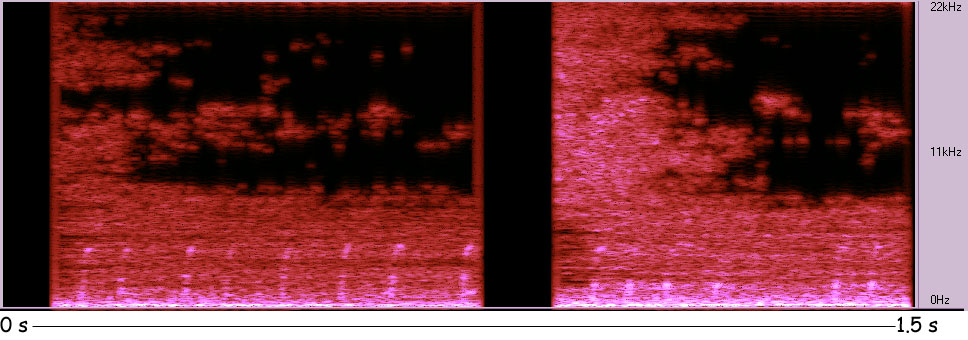
~~
14.  "Loud Whistle"
"Loud Whistle"
Profile157
, 169:
A loud sound of average duration 0.15-0.225 s, exclusive to pups. This
vocalisation has a typical frequency range of 3 kHz to 40 kHz but can extend up
to 61.6 kHz, well into the ultrasonic region. It consists typically of 4-12
unmodulated harmonics, most energy in the call is contained in the 10 kHz
region. Most commonly used 2 times in succession, singularly to up to 5 times in
succession, it is often interspersed with ‘low whistle’ vocalisations.
Expression: Usually vocalised with an open mouth, typically broadcast. Used
exclusively by male and female pups whilst playing away from the nest with a
littermate or during isolation. Its use decreases until pups are roughly six
weeks old. Effect: May stimulate retrieval and return to nest of the subject by
conspecific; to elicit care from an adult. Likely function: Used to promote care
and protection of the subject from potential danger. Note that it is not yet
clear whether adults can hear the ultrasonic components of this call. Research
has found that some of the properties of this call, such as duration and minimum
frequency, vary significantly between litters and with behavioural context,
which suggests there is the possibility for individual pup and context
recognition by adult degus169.
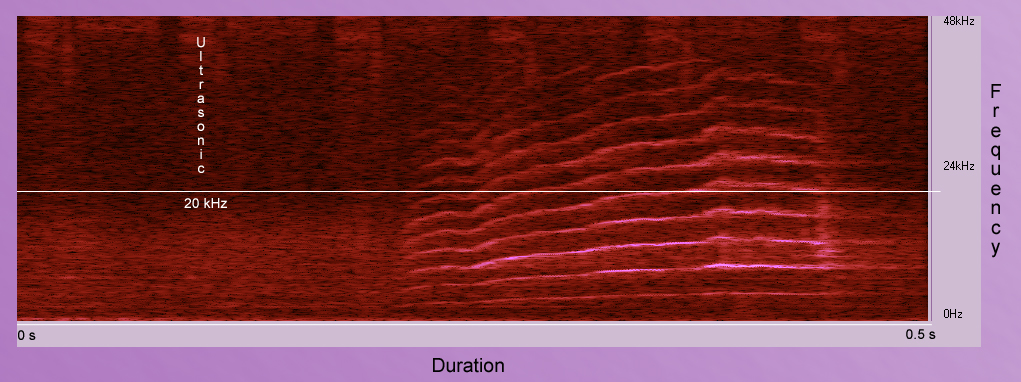
~~
15.  "Low Whistle"
"Low Whistle"
Profile157:
A soft sound of average duration 0.094 s, exclusive to pups. This vocalisation
has a frequency range of 3.4 kHz to 1.1 kHz, consisting typically of an
unmodulated fundamental frequency. Most commonly used 3 times in succession,
singularly to up to 15 times in succession, may be interspersed with ‘whine’
vocalisations. Expression: No obvious outward physical characteristics,
typically directed toward a conspecific. Used exclusively by male and female
pups more or less continuously from birth, most commonly during pup care and
during isolation. Its use decreases until pups are roughly two weeks old.
Effect: No visible outward effect. Likely function: Possibly aids location of
pups and the nest by parents and conspecifics, since degus nest communally.
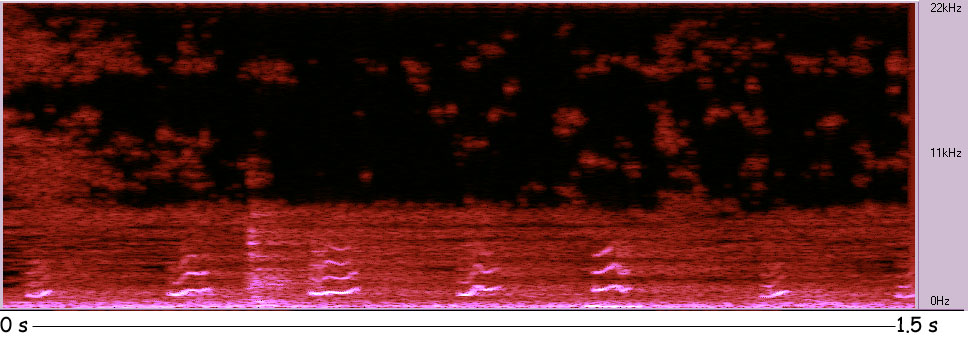
~~
The recommended
recording range for studying the vocalisations of the degu (particularly where
pups are present) is 20 Hz - 65 kHz169.
>EXAMPLES<
Listen to the following samples and see if you can identify the sounds labeled on the sonogram below.
 Male degu in
agonistic encounter (dispute involving food)
Male degu in
agonistic encounter (dispute involving food)
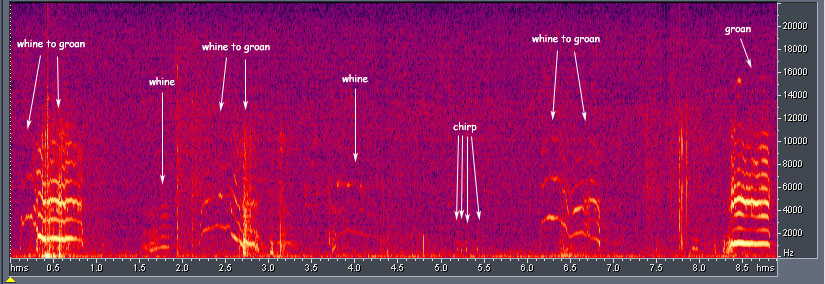
 Female degu caring for pups
('mothering call')
Female degu caring for pups
('mothering call')
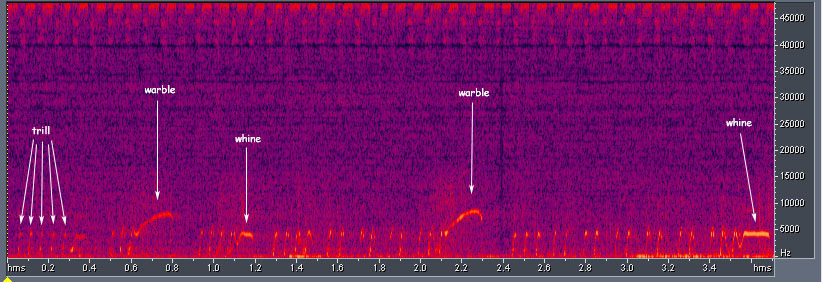
Degus use a variety of other methods to generate sounds. These include tail-beating30,
head thumping2
and drumming22.
Tail beating- Made by the degu rapidly banging its tail on the ground30.
Most frequently used when the degu gets excited, e.g. a male will often tail
beat immediately before mating30
, 132.
Head thumping- Made by the degu tapping its head against the roof of the
burrow or tunnel2.
Used to communicate through burrow systems and has the secondary function of loosening
dirt when excavating2.
Drumming- Made by the degu rapidly drumming its foot on the ground22.
Used as an alarm warning, may precede or follow an alarm call22.
This is an uncommon feature in domestic degus, suggesting it may be used in the wild
only to warn subterranean degus of surface danger.
Teeth grinding- There are two types: agonistic and passive.  The agonistic tooth
grind is very fast, and directed towards the offending conspecific. It is
often accompanied by agonistic vocalisations such as the 'wine' or 'grunt', and
lunges.
The agonistic tooth
grind is very fast, and directed towards the offending conspecific. It is
often accompanied by agonistic vocalisations such as the 'wine' or 'grunt', and
lunges.  The passive tooth grind is very different, it is much slower
and only used a few times in succession. The user is often in a relaxed state
and it may even be accompanied by yawning.
The passive tooth grind is very different, it is much slower
and only used a few times in succession. The user is often in a relaxed state
and it may even be accompanied by yawning.
Source 1: Long, C.V. (2007) 'Vocalisations of the degu (Octodon degus), a social
Caviomorph rodent.' Bioacoustics, 16: 223-244.
Source 2: Long, C.V. (2009) 'Pups of the degu (Octodon degus) include ultrasonic
frequencies in care-eliciting calls.' Proceedings of the Institute of
Acoustics, 31: 237-244.
Please note
that this material is covered by copyright law and must not be used or
reproduced in any way without permission.